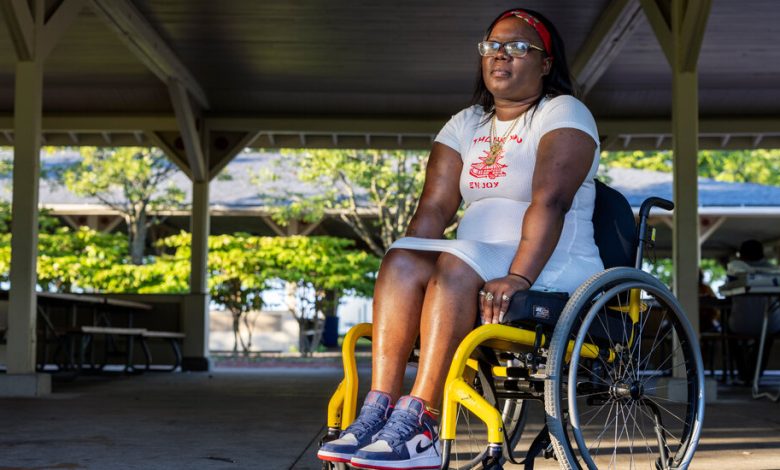Paralyzed by Gun Violence, They Seek Solace From Other Survivors

ROCHESTER, N.Y. — Three years after a former boyfriend kicked down her door, fired a gun at her nine times and left her paralyzed, Porche Powell steeled herself for a virtual visit to the hospital ward where she had spent long weeks in recovery.
Joining a video call, she saw a man lying in the same bed in the same room where she had been told that she would never walk again. His tearful description of being gunned down on a Rochester street jolted her back to her own struggles in Room 5-1200 — the physical medicine and rehabilitation unit that its occupants refer to as “the 512.”
When she left that unit, at Strong Memorial Hospital, a month after the shooting, Ms. Powell, 28, spent days sitting in empty rooms in her home with nothing to do. For almost a year, she couldn’t talk about her new life without crying, until a nurse connected her with a recently formed support group for gun violence survivors and others with spinal cord injuries.
The man in the hospital bed on the video call, Rickey Forcer Jr., would be its newest member. And, as Ms. Powell and other members welcomed him over the summer, they didn’t hold back. “It’s going to get worse when you first get home and have to adjust, before it gets better,” she told him, relating her own experience.
Though the death toll from mass shootings and gun violence across the United States tends to grab the most attention, in recent years those events have left a far greater number of people struggling with physical injuries, including lifelong paralysis.
Government agencies, including the Justice Department and the Centers for Disease Control and Prevention, do not track the number of Americans disabled by gun violence, and various sources provide divergent numbers when trying to identify the number of injured survivors. A 2020 study from public health researchers at the University of Pennsylvania and Columbia University estimated that there are more than 300 firearms injuries on average in America every day, leaving twice as many survivors as fatalities.
Although the severity of those injuries can vary greatly, advocates and medical professionals say the number of survivors with long-term disabilities is large and growing, in the thousands every year.
“We measure death, but we don’t always measure those who can’t be recorded,” said Emily Miller, a spokeswoman for the gun control advocacy group Everytown for Gun Safety.
Over the past decade, as the number of disabled survivors has grown, so have support networks like the one run by the Rochester Spinal Association, allowing victims and their families to lean on a community that understands the grief and pain of a life altered in a hail of gunfire.
“It feels like a forgotten sector of people,” said DeAndra Yates-Dycus, a mother from Indianapolis who started a support group and resource network after her son had been shot and paralyzed by a stray bullet during a children’s birthday party.
In Chicago, which has one of the highest rates of concentrated gun violence in the country, a chapter of Healing Hurt People assists a range of disabled survivors, including those who use wheelchairs and those with colostomy bags. “Society does not value their lives in the ways that they should,” said Andy Wheeler, one of the group’s coordinators, “and it’s horrible.”
Part of the reason they are often overlooked, Mr. Wheeler said, is that so many disabled survivors are young Black men — a group that society, and its support systems, often neglects. Shooting injury rates are highest among Black Americans, according to Everytown.
“A lot of Black men accept they’ll be shot at some point, and they’ll either die or survive it,” said Mike Patterson, one of the Rochester group’s unofficial founders, who was shot 21 years ago in Philadelphia and uses a wheelchair. “No one realizes there’s this third option — paralyzation — that can change your life forever.”
The rising tide of gun violence in Rochester, a city with an industrial past and newly swelling population, led Mayor Malik Evans to declare a state of emergency in July after a string of shootings, including the one that disabled Mr. Forcer. It has also continued to bring people to the attention of “the 512” survivors who are among the core of the new support group.
Since the fall, the Rochester network has begun accepting members from other states through the efforts of Chris Hilderbrant, the director of the Rochester Spinal Association, who has raised awareness of the group via social media and word of mouth.
For Ms. Powell, a certified nursing assistant for 12 years until she was shot, the group has given her a new way to care for others — and herself. “I realized sitting in a room, depressed all day, was not going to change my situation,” she said. “It wasn’t going to make me magically walk. I might as well just live life, see what I can do, find a new normal.”
Now, she has become one of the group’s leaders, offering insights and advice, as she did after Mr. Forcer introduced himself on the video call, describing through tears how he had survived a torn lung, three broken ribs and a severed spine after being shot during a dispute over selling marijuana.
“I’ve lived a whole 30 years being able to walk and run, play basketball with my son, box, drive every day,” Mr. Forcer said, “and now I’ve got to learn all that over again?”
He talked about how he had felt as he was lying on the ground, bleeding from the mouth and gasping for breath. “That’s how I was, too,” Ms. Powell responded. “The bullet had punctured my lungs, and I just couldn’t breathe.”
Just a few weeks later, Ms. Powell and many other group members gathered in a park on Lake Ontario for a rare treat: meeting in person.
They spread sandwiches and homemade brownies across picnic tables as their children and spouses joined them, enjoying a local band playing classic rock on the other side of the park. Ms. Powell’s 13-year-old daughter was there, chattering with a friend.
Ms. Powell recalled how her daughter had been by her side throughout the journey, even for the parts she had not wanted her to witness. That was part of what gave her motivation to become more active with the support group, she said.
“I was crying plenty days and plenty nights. I woke up every morning wishing that I could walk,” she said in that first meeting with Mr. Forcer. “But I try now. I’m able to do stuff for my kids. I cook for my kids. I clean. You could do anything a person walking can do. We just got to figure out a way to do it.”
As night fell on the picnic, the group went down to the beach, using a mat recently rolled out over the sand for wheelchair users, which led all the way to the water. It felt good, Ms. Powell said, to be together.
“The group,” she declared, “has been my therapy.”




